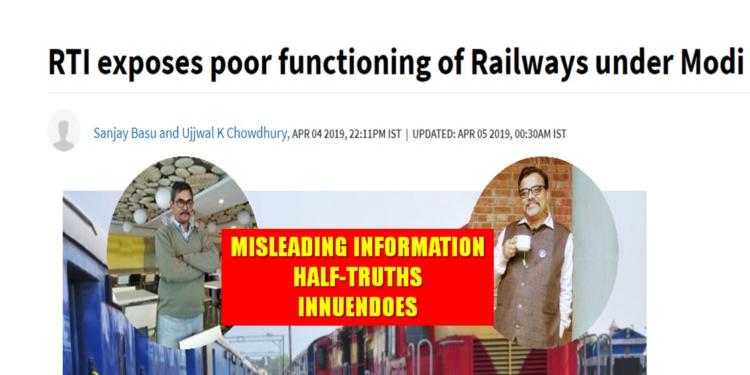Yesterday Karnataka based news daily, Deccan Herald, published a news report on Indian Railways. The report was titled ‘RTI exposes poor functioning of Railways under Modi’ and presented a very gloomy picture of the performance of Indian Railways in the last five years. The news article not only distorts the facts to suit a particular narrative but also relies heavily upon misleading information, half-truths, and innuendoes. The article and some of the ‘explosive’ snippets were widely shared on social media by Aam Aadmi Party members, left-liberal establishment and Congress sympathizers. “As for electrification, the first three years of the Modi government were wasted. In 2017-18, only 4.087 km were electrified,” read the article. The anti-Modi brigade started claiming that as per the RTI report, only 4 km of railways was electrified in 2017-18.
However, the fact is that 4,087 km of railway track was electrified in 2017-18. The electrification of railways grew exponentially under the Modi government. In October, a cabinet meeting led by PM Modi had approved 100 percent electrification of Indian Railways. “We have electrified about 46% of routes. The work is on for electrification of about 20,000 km of routes, after which about 78% of Indian Railways will be electrified. Today [Wednesday], the Cabinet has approved 13,675 km of remaining routes at the cost of 12,134 crore,” said Piyush Goyal after PM-led Cabinet Committee on Economic Affairs (CCEA) meeting.
From the facts given above, it is crystal clear that Deccan Herald article tried to peddle a false narrative. The article was written by Ujjwal K Chowdhury who claims to be ‘Media Educator, Change Aspirant, Humanist Democrat and Leading a media school’ in his Twitter bio. In his pinned tweet of July 2018, he has tagged the leaders of AAP, Congress, Swaraj Party and CPM with an article link in which he has outlined the strategies opposition should adopt to defeat Modi government.

In the article, titled ‘Roadmap for the opposition’, he outlines 4 political strategies, two governance strategies and two communication strategies the opposition should adopt to defeat the Modi government. In the last paragraph, he outlines that the opposition should unite and adopt a common platform to defeat the incumbent government.
The second writer of the Deccan Herald article named Sanjoy Basu’s bio reads, “Once an Entrepreneur. RTI activist. Volunteer @AamAadmiParty. Living for the betterment of common people of India. Hate hypocrisy and falsehood.” The Twitter profile of both writers is filled with anti-government tweets. It is very clear that both writers are ‘activists’, and not ‘journalists’.

Their sole aim is to defame the Modi government through facts or fiction. Prima facie, based on their social media activity, they appear to be more of social media warriors of Aam Aadmi Party and Congress than journalists interested in facts.
This is not the first incident that journalists are openly opposing the Modi government and supporting the opposition. Most of the leaders from AAP like Ashish Khaitan, Yogendra Yadav, Ashutosh have been associated with media, academia or entertainment. The same goes for the people in the Congress party.

When 100 percent electrification completes in 2022, India would be the second largest electrified railway network in the world behind China. Our Asian neighbor has 87,000 km of electrified rail network. However, China has only 68 percent of its railway (the country has 1, 27,000 km of railway network) electrified. So, India would be the only large railway network with 100 percent electrification. As of now, India has the third largest electrified rail network after China and Russia, almost two-thirds of freight and half of the passenger in the country moves on electric engines. These journalists with clear-cut agenda, shady sources, and unsubstantiated claims are detrimental to the very future of journalism.


































